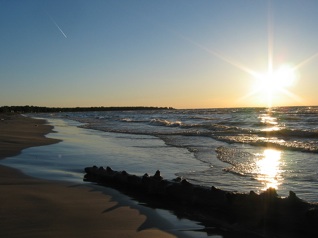
 May 8, 2009, Guelph, Ont. – Agricultural wastes are the main source of
May 8, 2009, Guelph, Ont. – Agricultural wastes are the main source of
E. coli bacteria contaminating Lake Huron, says a new study by
University of Guelph researchers.
May 8, 2009, Guelph, Ont. – Agricultural wastes are the main source of E. coli bacteria contaminating Lake Huron, says a new study by University of Guelph researchers.
 |
|
| A beach on Lake Huron. |
Almost two-thirds of the bacteria in the southeastern Lake Huron study site came from livestock waste, said Prof. Jack Trevors of the University of Guelph’s Department of Environmental Biology. This is the first report to show how much bacterial pollution comes from different sources between Goderich and Kincardine.
According to the study, livestock accounted for between 59 and 62 percent of E. coli entering the lake. The rest came from wildlife, human waste and unknown sources. Human sewage accounted for one to three percent, Trevors said.
He co-authored the study with University of Guelph environmental biologist Professor Hung Lee and researchers from the Ontario Ministry of the Environment. Their research paper appeared in the March issue of the Canadian Journal of Microbiology.
“We know agriculture is important to Ontario,” said Trevors. “We’re using scientific tools to learn about the environment and how to sustain and improve our water resources.”
The team compiled DNA samples from potential E. coli sources and compared those against samples taken in 2005 and 2006 from Lake Huron and the creeks and rivers feeding it.
Trevors said it’s useful to quantify how much bacterial pollution might come from different sources. “If you don’t know where it’s coming from, it’s difficult to mitigate the problem and protect recreational water. If you know where it’s coming from, you can try to implement management solutions to deal with it.”